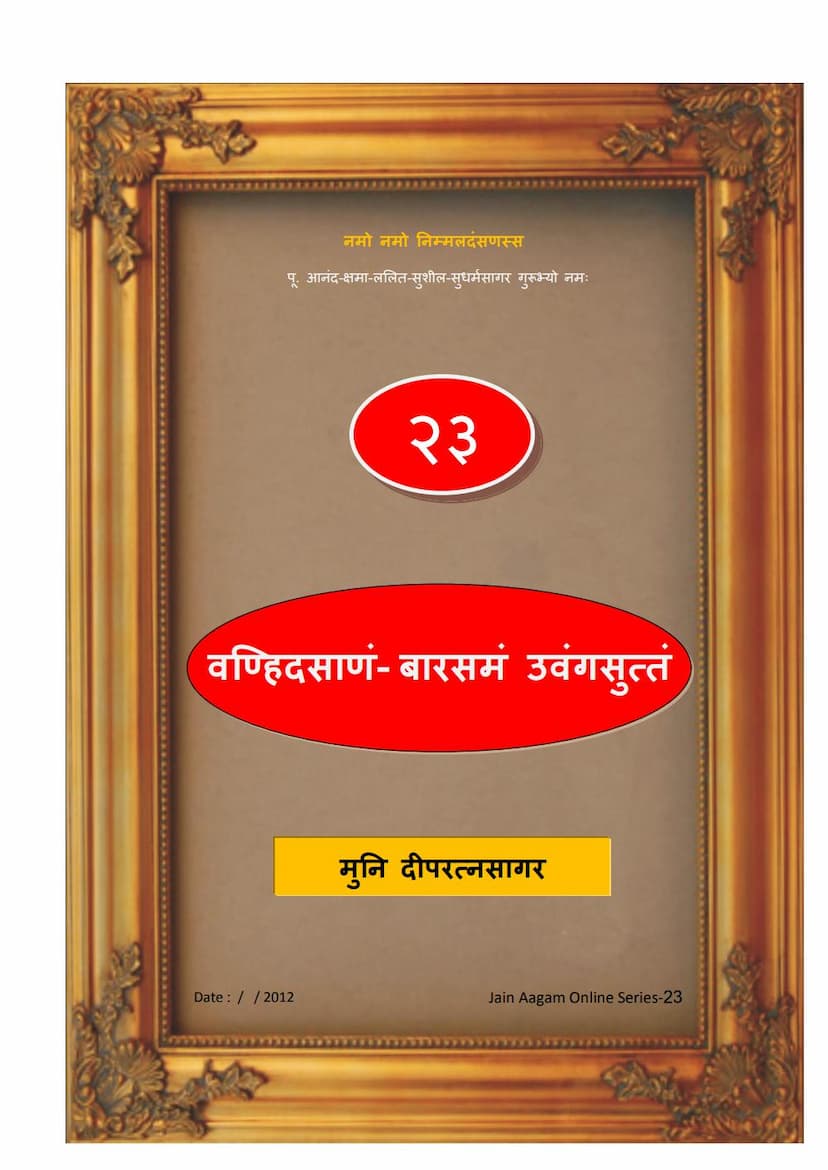Agam 23 Vanhidasanam Barasam Uvvangsuttam Mulam PDF File
Added to library: September 1, 2025

Summary
Here's a comprehensive summary of the provided Jain text, "Agam 23 Vanhidasanam Barasam Uvvangsuttam Mulam PDF File," based on the pages you've shared:
This document is a Jain Agam text, specifically the 23rd in a series, titled "Vanhidasanam - Barasam Uvang Suttam" (meaning the twelfth Uvang Sutra related to "Vanhidasanam"). It is attributed to Muni Deepratnasagar and published by Deepratnasagar, with a revision by Deepratnasagar himself. The text is presented as being for private and personal use only by Jain Education International.
Overall Structure and Content:
The text outlines the structure of the "Vanhidasanam Uvang Suttam," which consists of twelve chapters (adhyayana). It then delves into the first chapter, titled "Nisadhe" (meaning "Nisada," likely a name or concept).
Key Themes and Narrative Elements:
-
The Vanhidasanam Uvang Suttam: The text begins by referencing the teachings of Lord Mahavira, stating that there are twelve chapters in the fifth varga (section) of the Upangas, dedicated to "Vanhidasanam." The titles of these twelve chapters are listed: Nisadhe, Mayani, Vaha, Vahela, Pragata, Jukti, Dasaratha, Dadharaha, Mahadhanu, Saptadhanu, Dasadhanu, and Shatadhanu.
-
The City of Vasantpur and the Mountain Revatak: The narrative sets the scene in a city called Vasantpur (identified later as Baravati), which is described as being twelve yojanas long and nine yojanas wide, resembling a celestial abode due to its grandeur. Outside the city, to the northeast, lies the Revatak mountain, depicted as tall, touching the sky, and adorned with various trees, bushes, creepers, and flowers. It's also described as being filled with rivers, streams, caves, coral formations, and peaks, inhabited by celestial beings, Vidyadharas, and various animals like swans, deer, peacocks, cranes, and chakravakas.
-
Nandanvan Garden and Surapriya Yaksha: Adjacent to Mount Revatak is the Nandanvan garden, also described as beautiful and filled with flowers. Within this garden is a shrine dedicated to the Yaksha Surapriya, which is a popular place of worship for many people.
-
King Vasudeva of Baravati: The text introduces King Vasudeva as the ruler of Baravati. He is described as having powerful relatives and a vast retinue, including Baladeva, various kings, princes, and merchants. He governs the southern half of the Bharata continent, extending from the Vedadri mountain.
-
Baladeva and Queen Revati: Baladeva is also mentioned as a king in Baravati. He is married to Queen Revati, who is described as being beautiful and fortunate.
-
Queen Revati's Dream: Queen Revati experiences a dream of a lion while sleeping on a comfortable bed. This dream is interpreted as a sign of a good omen, and the text briefly mentions the tradition of dream interpretation, likening it to that of Mahabala. It also mentions the marriage of forty-five princesses to the king.
-
Nisada Kumar and His Spiritual Journey:
- The story focuses on Nisada Kumar, who lives in a magnificent palace. He hears the discourse of a mendicant (likely Lord Ariṣṭanemi, the Arhat) and is deeply impressed, becoming a follower of the Jaina faith.
- His preceptor, Varadatta, recognizes Nisada Kumar's potential for spiritual advancement.
- The text recounts Nisada Kumar's past life. He was a king named Mahabala in a city called Rohidaka, ruled by King Mahabala and Queen Padmavati. He had a dream of a lion, indicating a significant birth. He married thirty-two royal princesses. After enjoying worldly pleasures for a long time, he renounced the world and became an ascetic, practicing austerities for forty-five years, ultimately achieving salvation.
- In his current life, Nisada Kumar is identified as the son born to Baladeva and Queen Revati, implying a continuation of his spiritual journey.
- Nisada Kumar, after becoming a Shramanopasaka (lay follower of Jainism), develops a strong desire to meet the Arhat Ariṣṭanemi. He stays in a Poshadhashala (place of religious observance) and reflects on the auspiciousness of the places where the Arhat resides and the people who honor him.
- He expresses a wish to meet the Arhat if he were to visit the Nandanvan garden.
- Lord Ariṣṭanemi, aware of Nisada Kumar's innermost thoughts, arrives at the Nandanvan garden with a large assembly of ascetics.
- Upon hearing this, Nisada Kumar, filled with joy, takes leave of his parents and renounces the world, becoming an ascetic.
- As an ascetic, Nisada Kumar diligently studies the eleven Angas under the guidance of Lord Ariṣṭanemi's senior disciples. He practices intense austerities for nine years, eventually fasting to death. After fulfilling his spiritual duties, he attains a high celestial abode, the Savvatthasiddhi Viman, with a lifespan of thirty-three Sagaropama.
-
The Fate of Nisada Kumar:
- After his celestial lifespan ends, Nisada Kumar will be reborn as a prince in the city of Unna in the Mahavideha continent.
- He will eventually attain Kevala Jnana (omniscience) under the guidance of senior monks and then renounce the world again to become an ascetic.
- Through further severe austerities, he will ultimately achieve liberation (Moksha), ending all suffering.
-
Varadatta's Inquiry and Lord Ariṣṭanemi's Response: The text concludes with Varadatta, the ascetic disciple, inquiring about Nisada Kumar's final destination. Lord Ariṣṭanemi confirms Nisada Kumar's spiritual progress and future liberation.
In essence, this excerpt from the Vanhidasanam Uvang Suttam narrates the story of Nisada Kumar, tracing his past life, his spiritual awakening, his renunciation of the world, and his eventual path towards ultimate liberation, highlighting the principles of karma, rebirth, and spiritual discipline within Jainism.